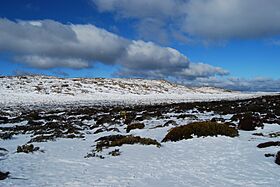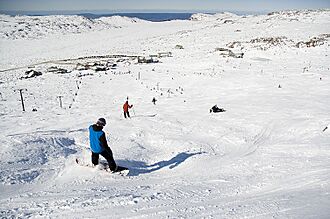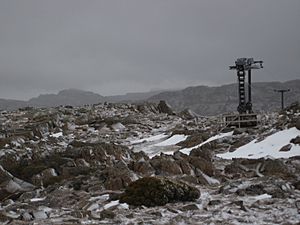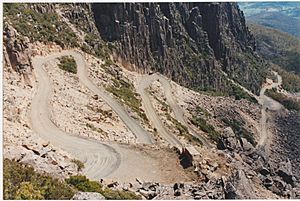Ben Lomond (Tasmania) facts for kids
Quick facts for kids Ben Lomond |
|
|---|---|
| Palawa kani: turapina | |

Snowfields on Ben Lomond
|
|
| Highest point | |
| Elevation | 1,572 m (5,157 ft) |
| Parent peak | Mount Ossa |
| Naming | |
| Native name | Error {{native name}}: an IETF language tag as parameter {{{1}}} is required (help) |
| Geography | |
| Location | Tasmania, Australia |
| Geology | |
| Age of rock | Jurassic |
| Mountain type | Dolerite |
| Ben Lomond Alpine Resort | |
|---|---|

Ben Lomond summit run
|
|
| Location | Ben Lomond |
| Nearest city | Launceston |
| Vertical | 112 metres (367 ft) |
| Top elevation | 1,572 metres (5,157 ft) |
| Base elevation | 1,460 metres (4,790 ft) |
| Runs | 10 |
<mapframe frameless text="Map of Ben Lomond National Park" width="300" height="300" latitude="-41.5611" longitude="147.6614" zoom="9" align="right"> { "type": "ExternalData", "service": "geoshape", "ids": "Q816402", "properties": { "title": "Ben Lomond National Park", "fill": "#447F06", "stroke-width": 0 } } </mapframe>
Ben Lomond is a big mountain in the north-east of Tasmania, Australia. It has a large flat top, called a plateau, which is over 1,200 meters high. The very highest point on this plateau is Legges Tor, which is 1,572 meters tall. Another impressive part is Stacks Bluff, which is 1,527 meters high and has cliffs that drop 600 meters!
Ben Lomond is located east of Launceston and is part of the Ben Lomond National Park. It's famous for having Tasmania's best Alpine skiing slopes. Because it's easy to reach from Launceston and has a ski village, Ben Lomond is a popular spot for tourists and hikers all year round. You can get to the village and the top by walking trails or by a winding road called "Jacobs Ladder."
The area around the mountain is also called Ben Lomond. It's about 64 kilometers east of Longford.
Contents
Ben Lomond: An Amazing Mountain in Tasmania
What is Ben Lomond?
Ben Lomond is a large mountain in Tasmania, Australia. It's known for its wide, flat top, called a plateau. This plateau is home to many interesting plants and animals. The highest point is Legges Tor, standing at 1,572 meters. Another impressive part is Stacks Bluff, with its tall cliffs.
Ben Lomond is also a popular place for skiing and hiking. It's part of a national park, which helps protect its unique environment.
The History of Ben Lomond's Name
The mountain has a rich history, including names given by the first people of Tasmania.
Aboriginal Names and Meanings
The original people of Tasmania, the Tasmanian Aboriginals, called Ben Lomond turapina. This name might mean "tableland" or "plateau" with "bluff" or "cliffs." They had other names for different parts of the mountain too.
For example, the plateau between the Nile River valley and Stacks Bluff was called parndokenne. A lake on the plateau, now called Lake Youl, was known as minamata. This name means "lake" or "lagoon" and is still used for some smaller lakes nearby, called the Menamatta Tarns. This is special because it's one of the few places in Tasmania that kept its traditional Aboriginal name.
How Ben Lomond Got Its European Name
Even though Matthew Flinders saw the mountain, it was named by Colonel Paterson in 1804. He named it after a mountain in Scotland. The name "Ben Lomond" usually refers to the whole mountain area, including the plateau and the national park. Over time, other parts of the mountain were named after explorers, surveyors, or local people.
Nature and Wildlife at Ben Lomond
Ben Lomond National Park is a special place for nature. It protects many unique plants and animals that live in the alpine areas of Tasmania.
Rocks and Landforms
The mountain is mostly made of a type of rock called Dolerite. This rock formed a very long time ago, during the Jurassic Period. During the Ice Age, Ben Lomond had a small ice cap. This ice shaped the mountain, creating the rocky, alpine scenery you see today. Much of the plateau is covered in large rocks and has very little soil.
Plants of the Mountain
Ben Lomond is home to many different kinds of plants. Even though some areas are very stony, you can find a wide variety of plants, from small alpine plants to dense forests. Over 220 different plant species have been found here! Some common plants include tussock grass and various shrubs. You can also see "cushion plants," which grow in tight, low clumps. One rare plant, the rock cushion plant, is only found in a small area within the park.
Animals You Might See
Ben Lomond is full of wildlife! You might spot Bennett's wallabies and wombats, even in the ski village during winter. Pademelons live in the wet, bushy areas. Eastern quolls and dusky antechinus are sometimes seen near the lodges. You might also see an echidna or even a platypus in the Upper Ford River.
Many other animals live here, like possums, gliders, and different kinds of bats. For birds, you might see large Wedge-tailed eagles flying overhead or noisy yellow-tailed black cockatoos. There are also many unique Tasmanian birds like the green rosella and various honeyeaters. The northern snow skink, a special lizard, lives only on mountain tops in Tasmania, including Ben Lomond.
The Story of Ben Lomond's First People
Ben Lomond was originally the home of the Ben Lomond Nation, a group of Aboriginal people. They lived on this land for thousands of years.
Life Before European Settlers
The Ben Lomond Nation had several clans, or family groups. They hunted in the valleys of the South Esk and North Esk rivers. In the summer, they would travel up to the plateau. There are signs that they regularly used the plateau, like stone tools found near Lake Youl. They even had quarry sites where they gathered stone for tools. Their way of life was connected to the land and its seasons.
Changes After European Arrival
In the early 1800s, European settlers began to move into the Ben Lomond area. This changed the traditional way of life for the Aboriginal people. Farms were set up, which made it harder for the Aboriginal people to move freely and hunt. This led to conflict and difficult times for the Ben Lomond Nation.
Eventually, many Aboriginal people from different nations, including the Ben Lomond people, were moved to Swan Island and then to Wybalenna on Flinders Island. This was a very hard time for them, but their culture and heritage survived through their descendants. Today, many people in Tasmania have cultural and family connections to the Ben Lomond Nation.
Exploring and Developing Ben Lomond
Over the years, many people have explored and developed Ben Lomond.
Early European Exploration and Surveys
The first European to likely climb the mountain was John Batman in 1829. He noted the Aboriginal tracks leading to the top. Later, in 1833, the artist John Glover visited with surveyor John Wedge. They made sketches of the mountain's features.
The first scientific visit was by Paul Edmond de Strzelecki in 1841. He tried to measure the height of Stacks Bluff. Later, detailed surveys were done in the early 1900s, which helped map the mountain and name its features.
Mining History
People looked for gold on Ben Lomond as early as 1854. While some gold was found, it was more successful in nearby areas like Tower Hill. Other minerals like tin and tungsten were also mined in the foothills of Ben Lomond. Coal was found on the plateau in 1829 and was even mined for local use in the ski village.
Protecting the Mountain: National Park Status
People started suggesting that Ben Lomond should be a protected area around 1910, partly because of frequent fires. Finally, in July 1947, Ben Lomond was officially declared a National Park and Scenic Reserve. This helped protect nearly 40,000 acres of land.
Fun Activities at Ben Lomond
Ben Lomond is a fantastic place for outdoor activities, especially hiking, skiing, and cycling.
Hiking and Walking Trails
People have been walking on Ben Lomond for a long time. By the 1880s, it became very popular. There were tracks leading up to the plateau from different towns. Today, you can find marked trails from the northern, north-eastern, and south-eastern sides of the mountain.
A popular track goes from the Scout hut at Carr Villa to the summit. Another trail from Storys Creek leads past Tranquil Tarn to Stacks Bluff, offering amazing views of eastern Tasmania. The plateau itself is great for open walking, even if there aren't many marked trails.
Skiing Adventures
Skiing started to become popular on Ben Lomond in the 1920s. The Northern Tasmanian Alpine Club helped make trips to the mountain easier. In 1932, a chalet called 'Carr Villa' was built to help skiers access the slopes. Later, a permanent hut was built on the summit for overnight stays.
In 1950, it was suggested that Ben Lomond should become a ski resort. The Australian National Championships were even held there in 1955! In 1963, the famous "Jacobs Ladder" road was built, making it much easier to reach the top of the plateau. Since then, new ski lifts, visitor facilities, and accommodation have been added. Ben Lomond is now Tasmania's top spot for Alpine skiing.
Cycling Challenges
The steep "Jacobs Ladder" road is famous as a training ground for professional cyclists like Richie Porte. It's also a popular destination for cyclists who enjoy a challenging ride. Mountain bikers can explore the fire trails around the mountain or try downhill rides on Jacobs Ladder. There are even multisport events held in the area.
Where is Ben Lomond?
The Ben Lomond area covers about 182.6 square kilometers. Most of this land is part of the Ben Lomond National Park. The main road, C432 (Ben Lomond Road), leads from the north-west to the ski village.
Images for kids
See also
 In Spanish: Ben Lomond (Australia) para niños
In Spanish: Ben Lomond (Australia) para niños









